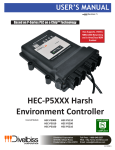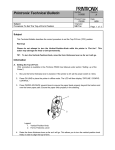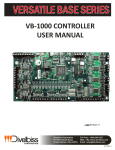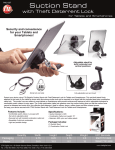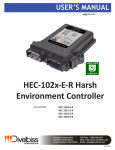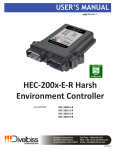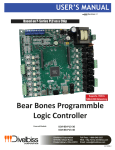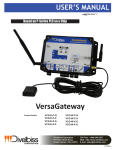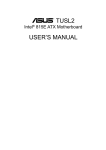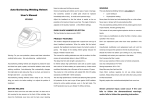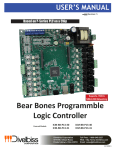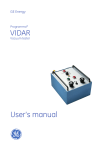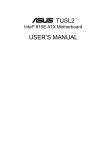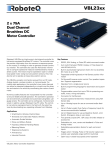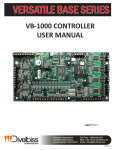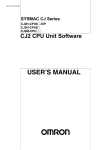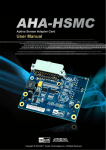Download HEC-P5XXX Harsh Environment Controller
Transcript
USER’S MANUAL Revision: 4 Based on P-Series PLC on a ChipTM Technology Now Supports J1939 & NMEA 2000 Networking HEC-P5XXX Harsh Environment Controller Covered Models: HEC-P5000 HEC-P5100 Divelbiss Corporation 9778 Mt. Gilead Road, Fredericktown, Ohio 43019 Toll Free: 1-800-245-2327 Web: http://www.divelbiss.com Email: [email protected] 2012006.4 Table of Contents Manual Contents Getting Started How to Use this Manual........................................................................ 3 The HEC-P5xxx Controller Overview...................................................... 4 Configuring the HEC-P5xxx Target in EZ LADDER Toolkit....................... 4 Loading the HEC-P5xxx Kernel............................................................... 6 Getting to Know the HEC-P5xxx............................................................. 8 Assembling / Dis-Assembling the HEC-P5xxx...................................... 10 HEC-P5xxx Internal Field Configuration Jumpers and Switches........... 11 HEC-P5xxx Features Programming Port............................................................................... 14 Status (STS) LED................................................................................... 15 Power (PWR) LED................................................................................. 15 Programmable LEDs (I1 / I2)............................................................... 15 Input Power......................................................................................... 15 Input Power Monitor........................................................................... 16 Mounting............................................................................................. 16 Digital Inputs....................................................................................... 16 Counter Inputs..................................................................................... 19 Quadrature Input................................................................................. 22 Digital Outputs..................................................................................... 23 Pulse Width Modulation Outputs........................................................ 25 PWM Channel Load Current Feedback................................................ 26 Analog Inputs....................................................................................... 27 Real Time Clock - - Model HEC-P5000................................................ 28 General Purpose Serial Ports - Model HEC-P5000............................... 28 CAN Networking Ports......................................................................... 30 EEPROM / Retentive Memory............................................................. 33 SD Card Memory................................................................................. 34 Ethernet Communications - Model HEC-P5000................................... 35 Other HEC-P5xxx Target Settings......................................................... 39 Structured Text Support...................................................................... 39 Hardware Specifications...................................................................... 39 HEC-P5XXX User’s Manual Document #: 2012006.4.pdf Divelbiss Corporation • 9778 Mt. Gilead Road • Fredericktown, Ohio 43019 • 1-800-245-2327 • www.divelbiss.com PAGE 1 of 40 Getting Started This section explains how to read this manual and understand the symbols and information that it contains. To begin using your HEC-P5XXX Controller, you will need to follow these steps: • Install EZ LADDER Toolkit if not already installed (not included). • Configure the HEC-P5XXX Controller in the EZ LADDER Toolkit Project Settings. • Using purchased or self-made cables, connect the Input Power and Programming Port. • Write a ladder diagram program. • Install the HEC-P5XXX’s Kernel if this is a new unit from the factory. • Download and run the program on the Controller. Refer to the appropriate sections of this manual for details on the above items. WARNING!! The HEC-P5XXX Controller, as with other programmable controllers must not be used alone in applications which could be hazardous to personnel in the event of failure of this device. Precautions must be taken by the user to provide mechanical and/or electrical safeguards external to this device. This device is NOT APPROVED for domestic or human medical use. Getting Started How to Use this Manual In this manual, the following conventions are used to distinguish elements of text: BOLD italic SMALL CAPS Denotes labeling, commands, and literal portions of syntax that must appear exactly as shown. Used for variables and placeholders that represent the type of text to be entered by the user. Used to show key sequences or actual buttons, such as OK, where the user clicks the OK button. In addition, the following symbols appear periodically in the left margin to call the readers attention to specific details in the text: Warns the reader of a potential danger or hazard associated with certain actions. Appears when the text contains a tip that is especially useful. Indicates the text contains information to which the reader should pay particularly close attention. All Specifications and Information Subject to Change without Notice HEC-P5XXX User’s Manual Document #: 2012006.4.pdf Divelbiss Corporation • 9778 Mt. Gilead Road • Fredericktown, Ohio 43019 • 1-800-245-2327 • www.divelbiss.com PAGE 3 of 40 Getting Started The HEC-P5xxx Controller Overview The HEC-P5XXX Harsh Environment Controller is a power upgrade to the Harsh Environment Controller product line. The HECP5XXX is based on the new P-Series PLC on a ChipTM. This new P-Series PLC on a ChipTM combines the easy to use functionality of the original P-Series PLC on a Chip with new exciting features and possibilities. The HEC-P5XXX boasts the following capabilities: • • • • • • • • • • • • • • • • • 8 to 32VDC Operation -40°C to 80°C Operating Temperature Range 16 Digital Inputs, Sinking or Sourcing (in groups) 3 Digital Inputs may be used as High Speed Counter Inputs with Software De-bounce Control 3 Digital Inputs may be used as a Quadrature Inputs with Software De-bounce Control 16 Digital Outputs, rated 2 Amps DC, 12 Support Pulse Width Modulation (PWM) 6 Outputs Support Analog Current Feedback Monitoring Dual Serial Port Capability (RS232 / RS485) Ethernet Communications via Modbus TCP or Ethernet Port as Programming Port Supports Multiple Modbus Ports Internal Micro SD Card Dual CAN Ports, Support Divelbiss OptiCAN 2 Analog Inputs, Configured as 0-5VDC, 0-10VDC or 0-20mADC, 12 Bit Resolution Two Programmable LEDs, Power Monitor LED and Status/Watchdog LED Real Time Clock Retentive Memory and EEPROM Storage Input Power Monitor Some of the features listed above are based on the HEC-P5XXX model purchased. To gain the use of some features, other features may become unusable. Refer to the individual feature sections in this manual for details. Configuring the HEC-P5xxx Target in EZ LADDER Toolkit Before you can program and use the HEC-P5XXX Controller, it must be configured as a target within the EZ LADDER Toolkit. For help with installing or using EZ LADDER, please refer to the P-Series EZ LADDER User’s Manual. 1. In EZ LADDER, from the File Menu at the top, click PROJECT then SETTINGS. This will open the Project Settings Window. Select HEC-P5000 as the target from the choices. Refer to Figure 1.1. Verify the correct COM Port is selected. 2. Click the PROPERTIES button to the right side of the window. The HEC-P5000 Properties Window will open. 3. Using the Drop-down Part Number select box, select the model of the HEC-P5XXX. Refer to Figure 1.2. With the model selected, the Devices pane will update with the currently selected features for the HEC-P5XXX. The ADD DEVICE button is used to install and configure additional features (from those shown above) such as Ports, Real Time Clock, etc. For this example, we will not add additional features at this time. These features may be installed and configured by re-visiting this window. 4. Click OK. This will close the HEC-P5000 Properties window and save the model selected. 5. Click OK. This will close the Project Settings Window, saving the target and installed features for this ladder diagram project. Note: Any features not shown when clicking ADD DEVICE are already installed when the target is selected. HEC-P5XXX User’s Manual Document #: 2012006.4.pdf Divelbiss Corporation • 9778 Mt. Gilead Road • Fredericktown, Ohio 43019 • 1-800-245-2327 • www.divelbiss.com PAGE 4 of 40 Getting Started Figure 1.1 - Project Settings Window Figure 1.2 - HEC-P5000 Properties Window HEC-P5XXX User’s Manual Document #: 2012006.4.pdf Divelbiss Corporation • 9778 Mt. Gilead Road • Fredericktown, Ohio 43019 • 1-800-245-2327 • www.divelbiss.com PAGE 5 of 40 Getting Started Loading the HEC-P5xxx Kernel THE HEC-P5xxx WILL NOT FUNCTION UNLESS THIS STEP (KERNEL LOADING) IS COMPLETED. The kernel is the firmware for the controller and to provide greater flexibility and reliability, HEC Controller shipments are factory shipped without a kernel. If this is a new unit from the factory, it will be necessary to load the kernel before a ladder program can be downloaded. If the kernel is already loaded, this step is not required. To upgrade a kernel, see the P-Series EZ LADDER User’s Manual. To install the HEC-P5xxx’s kernel: 1. Verify the target has been configured (see Configuring the HEC-P5xxx Target in EZ LADDER Toolkit). 2. Connect the Programming cable(s) from the computer to the HEC-P5xxx. See Programming Port in the HEC-P5xxx Features section. 3. Create a small one-rung program with a normally open (direct contact) and an output tied together. You may also open a preexisting program for the HEC. EZ LADDER version 1.0.4.4 and later includes a sub-directory (...EZ LADDER\Kernel Install Start Programs\)which has starter programs for each target to load the kernel. Choose GetStarted_HEC-P5xxx.dld. XXX = Model Number. 4. Click the (Compile) button 5. Click the (Monitor) button to change from the ‘Edit’ to ‘Monitor’ Mode. 6. Click the (Connect) button to connect to the target. A dialog will appear automatically when no kernel is loaded. If this dialog does not appear, click PROJECT then BOOTLOADER. 7. Click the BROWSE button and select the target’s kernel (by partnumber) located by default at C:\Program Files\EZ Ladder\Kernel\. Refer to Figure 1.3. The following are kernel names and descriptions: File Name Description HEC_P5000.dat Kernel for HEC-P5xxx To be Used on (Partnumber) HEC-P5000, HEC-P5100 8. Click the OPEN button to finish the kernel selection. Make sure the correct kernel is chosen. 9. Click the UPDATE TARGET button to install the kernel. Refer to Figure 1.4. 10. A dialog box will appear to show the status of the kernel installation. This could take a couple of minutes to install. 11. When the dialog windows close, the installation is complete. The HEC is ready to use and may be connected to and programs may be downloaded. HEC-P5XXX User’s Manual Document #: 2012006.4.pdf Divelbiss Corporation • 9778 Mt. Gilead Road • Fredericktown, Ohio 43019 • 1-800-245-2327 • www.divelbiss.com PAGE 6 of 40 Getting Started Figure 1.3 - Selecting the Kernel File Figure 1.4 - Updating the Kernel / Target HEC-P5XXX User’s Manual Document #: 2012006.4.pdf Divelbiss Corporation • 9778 Mt. Gilead Road • Fredericktown, Ohio 43019 • 1-800-245-2327 • www.divelbiss.com PAGE 7 of 40 Getting Started Getting to Know the HEC-P5xxx The HEC-P5xxx Controller is designed to provide powerful programmable features in a tough, harsh environment resistant package. The main features of the HEC-P5xxx are accessed via four (4) sealed Deutsch connectors that will be referred to as the ‘A’ connector which is grey, the ‘B’ connector which is black, the ‘C’ connector which is green and the ‘D’ connector which is brown. Figure 1.5 illustrates the HEC-P5xxx controller and it’s standard features. Figure 1.2 - HEC-P5xxx Illustration Each HEC connector is a Deutsch sealed connector with 12 connections each. The mating connectors for the HEC-P5000 are sold separately. Connectors may be purchased as kits or cable assemblies may be purchased with the mating connectors pre-wired with flying leads on one end. In addition to connectors and kits for standard wiring, programming break-out cable assemblies may be purchased. Refer to Figure 1.6 for the HEC-P5xxx connectors A, B, C and D front view Pin Assignments. HEC-P5XXX User’s Manual Document #: 2012006.4.pdf Divelbiss Corporation • 9778 Mt. Gilead Road • Fredericktown, Ohio 43019 • 1-800-245-2327 • www.divelbiss.com PAGE 8 of 40 Getting Started Figure 1.6 - HEC-P5xxx Connectors - Front View A,B, C and D Connector Pin Functions CONNECTOR ‘A’ (GRAY)CONNECTOR ‘B’ (BLACK) Pin 1 Pin 2 Pin 3 Pin 4 Pin 5 Pin 6 Pin 7 Pin 8 Pin 9 Pin 10 Pin 11 Pin 12 + Input Power (8-32VDC) - Power In (Gnd) Programming Port TX Programming Port RX CAN Port 0 Low CAN Port 0 High CAN Port 1 Low CAN Port 1 High Analog Input 0 Signal Analog Input 1 Signal Digital Input 0 / Counter Input 0 Digital Input 1 / Counter Input 1 Pin 1 Pin 2 Pin 3 Pin 4 Pin 5 Pin 6 Pin 7 Pin 8 Pin 9 Pin 10 Pin 11 Pin 12 DOT Group B: Digital Output 6 (PWM 6) DOT Group B: Digital Output 7 (PWM 7) DOT Group C: Digital Output 8 (PWM 8) DOT Group C: Digital Output 9 (PWM 9) DOT Group C: Digital Output 10 (PWM 10) DOT Group C: Digital Output 11 (PWM 11) DOT Group C: Power Source DOT Group D: Digital Output 12 DOT Group D: Digital Output 13 DOT Group D: Digital Output 14 DOT Group D: Digital Output 15 DOT Group D: Power Source CONNECTOR ‘C’ (GREEN)CONNECTOR ‘D’ (BROWN) Pin 1 Pin 2 Pin 3 Pin 4 Pin 5 Pin 6 Pin 7 Pin 8 Pin 9 Pin 10 Pin 11 Pin 12 HEC-P5XXX User’s Manual Digital Input 2 / Counter Input 2 Digital Input 3 / Quad Input A Digital Input 4 / Quad Input B Digital Input 5 / Quad Input Index DIN Group A Common DIN Group A: Digital Input 6 DIN Group A: Digital Input 7 DIN Group A: Digital Input 8 DIN Group A: Digital Input 9 DIN Group A: Digital Input 10 DIN Group B Common DIN Group B: Digital Input 11 Pin 1 Pin 2 Pin 3 Pin 4 Pin 5 Pin 6 Pin 7 Pin 8 Pin 9 Pin 10 Pin 11 Pin 12 DIN Group B: Digital Input 12 DIN Group B: Digital Input 13 DIN Group B: Digital Input 14 DIN Group B: Digital Input 15 DOT Group A: Power Source DOT Group A: Digital Output 0 (PWM 0) DOT Group A: Digital Output 1 (PWM 1) DOT Group A: Digital Output 2 (PWM 2) DOT Group A: Digital Output 3 (PWM 3) DOT Group B: Power Source DOT Group B: Digital Output 4 (PWM 4) DOT Group B: Digital Output 5 (PWM 5) Document #: 2012006.4.pdf Divelbiss Corporation • 9778 Mt. Gilead Road • Fredericktown, Ohio 43019 • 1-800-245-2327 • www.divelbiss.com PAGE 9 of 40 Getting Started Assembling / Dis-Assembling the HEC-P5xxx To dis-assemble the HEC Controller you will need a flat-head screwdriver. 1. Place the screwdriver as shown, press in on the locking latch (of the connector assembly) and push forward gently simultaneously to slide the locking latch out of the enclosure . 2. Repeat this for the second side and slide the entire connector assembly with the printed circuit board out of the enclosure. Push at Angle shown Push Latches each side with screwdriver & Slide Out Detail of Locking Latch Flat-End Screwdriver Push Latch Push at Angle shown Figure 1.7 - Disassembly of the HEC-P5000 Controller To assemble the HEC Controller: 1. Align the connector assembly with printed circuit board into the enclosure. The printed circuit board will align with the slots in the enclosure. 2. Slide the assembly completely into the enclosure until the locking latches are secure. Please note: If the HEC controller has an optional serial port, make sure the serial board wires do not interfere or get caught on the enclosure’s LED pipes (clear plastic tubes). HEC-P5XXX User’s Manual Document #: 2012006.4.pdf Divelbiss Corporation • 9778 Mt. Gilead Road • Fredericktown, Ohio 43019 • 1-800-245-2327 • www.divelbiss.com PAGE 10 of 40 Getting Started HEC-P5xxx Internal Field Configuration Jumpers and Switches To gain the most value of the many features included in the HEC-P5xxx controller, there are many options that may be configured in the field for actual needs. These options are configured using the internal configuration dip switches and jumpers. To configure these switches and jumpers, the HEC-P5xxx must be dis-assembled. There are three 5 position slide switch blocks, identified as SW1-SW3. Each block contains 5 individual switches that are used to configure options. When the switch is in the ON position, it is closed. In addition to the 5 position slide switch blocks, 2 additional single switches are included, SW4 and SW5. 3 Position jumper blocks are also provided for configurations. Figure 1.8 shows the locations of the switches and jumpers when the HEC-P5xxx has been opened. Figure 1.9 shows the different switch and jumper configurations. Figure 1.8 - HEC-P5xxx Configuration Switch and Jumper Locations HEC-P5XXX User’s Manual Document #: 2012006.4.pdf Divelbiss Corporation • 9778 Mt. Gilead Road • Fredericktown, Ohio 43019 • 1-800-245-2327 • www.divelbiss.com PAGE 11 of 40 Getting Started Switch # Function OFF ON SW1-1 CNTR Channel 0 Type PNP NPN SW1-2 CNTR Channel 1 Type PNP NPN SW1-3 CNTR Channel 2 Type PNP NPN SW1-4 Quadrature Channel A Type PNP NPN SW1-5 Quadrature Channel B Type PNP NPN SW2-1 Quadrature Channel Index Type PNP NPN SW2-2 Analog Input Channel 0 V/I Select Analog Input = Voltage Analog Input = Current SW2-3 Analog Input Channel 0 Voltage Range 0-5VDC 0-10VDC SW2-4 Analog Channel 1 V/I Select Analog Input = Voltage Analog Input = Current SW2-5 Analog Input Channel 1 Voltage Range 0-5VDC 0-10VDC SW3-1 Serial Port A RS485 Termination Resistor Disabled Enabled SW3-2 Serial Port B RS485 Termination Resistor Disabled Enabled SW3-3 Analog Input Channel 7 Voltage Monitor* Disabled Channel 7 = Input Voltage SW3-4 Analog Input Channel 7 DOT9 Feedback* Disabled Channel 7 = DOT 9 Current SW3-5 Real Time Clock Battery Enable Disabled Enabled SW4 CAN Port 0 Termination Resistor Disabled Enabled SW5 CAN Port 1 Termination Resistor Disabled Enabled * Only one of SW3-3 or SW3-4 should be set to ON at a time. Figure 1.9 - HEC-P5xxx Configuration Switch and Jumper Settings HEC-P5XXX User’s Manual Document #: 2012006.4.pdf Divelbiss Corporation • 9778 Mt. Gilead Road • Fredericktown, Ohio 43019 • 1-800-245-2327 • www.divelbiss.com PAGE 12 of 40 HEC-P5xxx Features This section explains the Harsh Environment Controller (HEC-P5xxx) hardware features, options and information regarding EZ LADDER Toolkit for basic operation. HEC-P5XXX Features Programming Port The HEC-P5xxx is programmed using its Programming Port (COM 0). This RS232 serial port is only to be used for programming using Divelbiss EZ LADDER Toolkit software. This is not a general purpose port and may not be used in any other capacity than programming the controller itself. The baud rate is factory set and cannot be changed between the HEC-P5xxx and EZ LADDER Toolkit. The HEC-P5xxx Programming Port is wired through the A Connector using pins 2, 3 and 4. The Programming Port requires a NULL MODEM cable or connection to the computer to establish communications between EZ LADDER Toolkit and the HEC Controller. Figure 2.1 represents a direct wiring connection from the PC to the HEC-P5xxx controller. This connection may be made by manufacturing your own programming cable. The mating connector for the HEC-P5xxx Programming Port may be purchased as a kits (Requires special Crimp Tool) or a complete pre-wired assembly for the A Connector (HECP100). A break-out cable set is available to allow in-line connections to the HEC-P5xxx’s programming port while still connecting I/O devices wired with an HEC-P100. Figure 2.1 shows the use of a break-out cable. Figure 2.1 - Programming Port Direct Connection Figure 2.2 - Programming Port Break-out Cable HEC-P5XXX User’s Manual Document #: 2012006.4.pdf Divelbiss Corporation • 9778 Mt. Gilead Road • Fredericktown, Ohio 43019 • 1-800-245-2327 • www.divelbiss.com PAGE 14 of 40 HEC-P5XXX Features Status (STS) LED The operating status of the HEC-P5xxx can be determined the by Status LED. When the Status LED is flashing at a slow rate, approximately once per second, then there is no ladder program executing. When the Status LED is flashing at a fast rate (several times per second), a program has been loaded and it is executing. If the Status LED appears to be flickering at a very fast rate, the Kernel is not running. Either the kernel needs to be installed or the controller reset to restart the kernel if it is installed. Should the Status LED not flash at all, first check the input power. If the input power is correct and there is still no Status LED, contact Divelbiss Technical Services. Power (PWR) LED The HEC-P5xxx provides a power green status LED that can be seen from the front of the unit. When this LED is illuminated, the input power should be sufficient for the HEC-P5xxx to operate. If the LED is not illuminated, the input power is too low for operation. Programmable LEDs (I1 / I2) The HEC-P5xxx includes two user programmable LED indicators (labeled I1 and I2). These indicators are controlled in the ladder diagram program by the variables PLED1 and PLED2 respectively. These indicators may be used to identify any number of conditions of the HEC-P5xxx controller or application. Input Power The HEC-P5xxx may be powered using 8-32VDC. The power is connected on the ‘A’ (Grey) connector using pins 1 (+V) and 2(-V/ Common). The power connected to these pins should be of sufficient current to source power for the controller logic, communication ports, analog and counter inputs. A typical input power wiring diagram is shown in Figure 2.3. Source power for the inputs is divided into two groups of five (5) inputs. Each group may be configured for sinking or sourcing and thus each group has an individual common pin that must be connected separately from the main controller power. Source power for the outputs is divided into four groups of four (4) outputs. Each output group has an individual power source pin that must be connected separately from the main controller power. While all the output power pins are separate from the main controller power, the output common (ground) for all connected loads must be tied to the same common (ground) connected to pin 2 of the main controller power. Failure to do this could result in unwanted operation or even damage the HEC-P5xxx controller. Figure 2.3 - Input Power Connections - Main Logic HEC-P5XXX User’s Manual Document #: 2012006.4.pdf Divelbiss Corporation • 9778 Mt. Gilead Road • Fredericktown, Ohio 43019 • 1-800-245-2327 • www.divelbiss.com PAGE 15 of 40 HEC-P5XXX Features Input Power Monitor The power connected to the main logic power input of pins 1 and 2 on connector ‘A’ may be monitored in the ladder diagram program. This input power is optionally connected to analog input 7 (AN7). The configuration switches SW3-3 must be set to ON and SW3-4 must be set to OFF for the power monitor to function. Refer to the HEC-P5xxx Internal Field Configuration Jumpers and Switches section of this manual for switch locations. When configured as the power monitor, the actual voltage is measured and is available in the ladder diagram program using variable AN7. AN7 is represented as an integer number and some logic must be added to the ladder diagram program to actually convert this raw analog value into volts. Figure 2.4 is an example ladder diagram program to convert AN7 into volts. AN7: R_AN2: R_Temp: AinScale: MaxScale: InputV: Power Monitor Analog Input (Integer) - Automatically created Variable used to store converted value of AN7 as a real variable type. This is required for calculations. Variable used to temporarily store values (real variable type) during calculations. Variable used to store maximum analog input scale value (real variable type).The default value = 4095.0 Variable used to store the maximum input voltage scale (real variable type). The default value = 40.0 Scaled analog input representing Input Voltage (real variable type) Figure 2.4 - Example Power Monitor Program for AN7 Note: Analog input 7 may be optionally configured to either be the input voltage to the controller (power monitor) or the load current feedback from digital output 9 (DOT9 / PWM9). The actual configuration is dependent upon how SW3-3 and SW3-4 are set. Mounting The HEC-P5xxx controller is designed to be panel mounted directly into most environments. The HEC-P5xxx mounts using 4 screws up to 1/4” in diameter. Even though the HEC-P5xxx can be submerged up to 3 meters in water, ideally, when mounting the HECP5xxx controller, the end with the connectors should be mounted downward as to promote moisture flow away from the connections. Figure 2.5 illustrates the HEC-P5xxx mounting hole locations and unit dimensions. Digital Inputs The HEC-P5xxx includes up to 16 on-board digital inputs. They are identified in EZ LADDER Toolkit and this manual as DIN0 through DIN15. The digital inputs are divided into four groups. Each digital input will operate from 8VDC to 32VDC. DIN0 - DIN2 (variables DIN0 - DIN2) These three (3) inputs may be used individually as digital inputs or as high speed counter inputs. These inputs may be configured as NPN or PNP inputs based on the configuration switches of SW1-1, SW1-2 and SW1-3. When configured as NPN, these inputs are pulled to the input power voltage. HEC-P5XXX User’s Manual Document #: 2012006.4.pdf Divelbiss Corporation • 9778 Mt. Gilead Road • Fredericktown, Ohio 43019 • 1-800-245-2327 • www.divelbiss.com PAGE 16 of 40 HEC-P5XXX Features Figure 2.5 - HEC-P5xxx Mounting & Dimensions DIN3 - DIN5 (variables DIN3 - DIN5) These three (3) inputs may be used individually as digital inputs or together as a quadrature input. These inputs may be configured as NPN or PNP inputs based on the configuration switches of SW1-4, SW1-5 and SW2-1. When configured as NPN, these inputs are pulled to the input power voltage. DIN6 - DIN10 (variables DIN6 - DIN10) These five (5) inputs are dedicated as digital inputs only. This group has it’s own common pin, allowing this entire group to be configured as sinking or sourcing based on the wiring. DIN11 - DIN15 (variables DIN11 - DIN15) These five (5) inputs are dedicated as digital inputs only. This group has it’s own common pin, allowing this entire group to be configured as sinking or sourcing based on the wiring. As digital input groups DIN6 - DIN10 and DIN11 - DIN15 are separate groups with individual common pins, these two groups can operate at different voltage between 8VDC and 32VDC. To read a digital input status in a ladder diagram, place and connect the appropriate contact for your needs. The DIRECT CONTACT and INVERTED CONTACT functions are used to read digital inputs in the ladder diagram. When placing the contact, verify you select the correct input address (DIN0 - DIN15) from the provided drop-down menu. Refer to Figure 2.6 for typical input connections. Figure 2.6 illustrates the different voltages that may be used as well as sinking and sourcing for digital input groups DIN6-DIN10 and DIN11-DIN15. HEC-P5XXX User’s Manual Document #: 2012006.4.pdf Divelbiss Corporation • 9778 Mt. Gilead Road • Fredericktown, Ohio 43019 • 1-800-245-2327 • www.divelbiss.com PAGE 17 of 40 HEC-P5XXX Features Each of the DIN0, DIN1 and DIN2 inputs have software enabled de-bounce circuitry. This circuitry typically should be enabled when these inputs are being used as digital inputs. When configured as counter/timer inputs, the de-bounce should typically be disabled. The de-bounce circuits for each input (DIN0 - DIN2) are enabled and disabled by adding the variables (coils) named DIN0_DEB, DIN1_DEB and DIN2_DEB respectively. When the variable (coil) is true, the de-bounce circuit is enabled and when the coil is false, the de-bounce circuit is disabled. The variables DIN0_DEB, DIN1_DEB and DIN2_DEB are automatically created by EZ LADDER when the HEC-P5000 target is selected. Deleting the de-bounce variables from the program will cause the de-bounce circuit to be enabled. This will reduce the frequency the input can read, resulting in inputs not operating properly depending upon the application. Figure 2.6 - Typical Digital Input Connections HEC-P5XXX User’s Manual Document #: 2012006.4.pdf Divelbiss Corporation • 9778 Mt. Gilead Road • Fredericktown, Ohio 43019 • 1-800-245-2327 • www.divelbiss.com PAGE 18 of 40 HEC-P5XXX Features Counter Inputs As was noted in the Digital Inputs Section, three of the digital inputs (DIN0, DIN1, DIN2) may be utilized as high speed counters. These counters may be configured in EZ LADDER to operate as an up counters, free running timers and triggered timers. These inputs will accept a maximum frequency of 100KHz and are optically isolated to promote noise immunity. These inputs are ideal to anywhere that high speed counting is required; such as calculating RPM, batch counting and more. Prior to using the high speed counter / timer inputs in the ladder diagram, the counter / timer functionality must be installed and configured in the ladder diagram’s Project Settings. The first step to installing the counter / timer functionality is to install the TimerCounter feature. Using menu, click PROJECT then SETTINGS to open the Project Settings window. With the target HEC-P5000 selected still, click the PROPERTIES button. The HECP5000 Properties Window will open. Verify the proper actual part number is selected in the Drop-down Part Number select box. Under the Devices, Internal section, if the counter / timer were installed, it would be listed. To install the counter / timer, click the ADD DEVICE button. From the available devices, select TimerCounter and click OK. Refer to Figure 2.7. Figure 2.7 - Installing Timer/Counter Device Figure 2.8 - Selecting Counter / Timer Channel The Timer / Counter Properties window will now appear. From this window, the actual counter/timer channel hardware will be installed. Click the ADD button. The Select Timer/Counter Channel window will appear. From the list provided, select the counter / timer channel to use. Refer to Figure 2.8. When selected, click OK. 1. TmrCntr0 is DIN0 2. TmrCntr1 is DIN1 3. TmrCntr2 is DIN2 The Tmr/Cntr Channel properties window will now open. Using the Drop-down Mode select box, select the type of operation for this particular counter / timer input. The choices are: Free Running Timer The input when configured as a Free Running Timer actually has no input functionality external to the HEC-P5xxx. The counter/timer channel on the PLC on a ChipTM uses an internal 1MHz reference clock and will count up at a 1 micro-second resolution. The TimerCounter function block in EZ LADDER provides additional controls for the timer/counter functionality. When the Free Running Timer mode is selected, no other configuration is required. Refer to Figure 2.9. HEC-P5XXX User’s Manual Document #: 2012006.4.pdf Divelbiss Corporation • 9778 Mt. Gilead Road • Fredericktown, Ohio 43019 • 1-800-245-2327 • www.divelbiss.com PAGE 19 of 40 HEC-P5XXX Features When the free-running timer reaches it’s upper counting limit, it will wrap negative and begin counting toward zero. This can be avoided by resetting the timer using the function block. Figure 2.9 - Timer/Counter as Free Running Timer Figure 2.10 - Timer/Counter as Counter Counter When configured as a counter, this input will count in the up direction. The Counter Mode can be configured for Rising Edge, Falling Edge or Both Edges. The number of counts per pulse on the input depends on the Counter Mode configuration. Select the Counter Mode using the provided Drop-down Counter Mode select box. Refer to Figure 2.10. The Pin should be set to the appropriate input (TMR_CAP0.0 for DIN0, TMR_CAP1.0 for DIN1 and TMR_CAP2.0 for DIN2). If the number of input pulses exceeds the counter’s upper counting limit, it will wrap negative and begin counting towards zero. This can be avoided by resetting the counter using the function block. Timer When configured as a timer, frequency or period may be measured of the signal to the input. This signal is referenced to a 24MHz clock internally. The operation is dependent on the configuration of the Timer Mode. Select the Timer Mode using the provided Drop-down Timer Mode select box. Selecting Frequency will configure for measuring the frequency of the signal on the input while selecting Period will configure for measuring period. Refer to Figure 2.11. Click OK. the number of times necessary to close and save all the configurations. You should return to the EZ LADDER Toolkit’s Edit workspace by clicking OK. the number of times required. Remember to Save your ladder diagram using the menu FILE and SAVE or SAVE AS. To use DIN0 - DIN3 in a ladder diagram, you must use the TIMERCOUNTER function block. This block, when placed in the ladder diagram, will provide a drop-down menu to select which counter to use. Refer to the P-13 EZ LADDER Toolkit User’s Manual for details on the TIMERCOUNTER and other function blocks. TmrCntr 0 is DIN0, TmrCntr1 is DIN1 and TmrCntr2 is DIN2. HEC-P5XXX User’s Manual Document #: 2012006.4.pdf Divelbiss Corporation • 9778 Mt. Gilead Road • Fredericktown, Ohio 43019 • 1-800-245-2327 • www.divelbiss.com PAGE 20 of 40 HEC-P5XXX Features Figure 2.11 - Timer/Counter Timer Please note: Individually, the DIN0 - DIN2 inputs are designed to be used as a digital input only or high speed counter/timer input only. EZ LADDER will allow the placement of contacts and /or TIMERCOUNTER function in any program. Therefore, you can place and use the contacts and the TIMERCOUNTER function block in the same program with the same digital input selected. This can be useful in some programs based on the application, but it is important to know that input contacts will only operate at a fraction of the frequency that the TIMERCOUNTER function block can accurately read. Each high speed counter/timer input can be field selected as either PNP (current sinking) or NPN (to accept signals from opencollector output devices). The type of device is selected by internal dip-switch settings on the HEC-P5xxx. To gain access to these dip-switches, the HEC-P5xxx must be dis-assembled. See the Assembling / Dis-assembling the HEC-P5XXX section of this manual. The switches SW1-1, SW1-2 and SW1-3 configures the counter/timer type of input for DIN0 to DIN2 respectively. When the switch is in the OFF position for the counter/timer input, the type is PNP. When the switch is in the ON position for the counter/timer, the type is NPN. Refer to the HEC-P5xxx Internal Field Configuration Jumpers and Switches section of this manual for switch locations. Figure 2.12 represents the timer/counter input diagrams and dip switch settings for PNP (current sinking) and NPN (open-collector input devices). Figure 2.12 - DIN0-DIN5 Example Input Circuit Each of the DIN0, DIN1 and DIN2 inputs have software enabled de-bounce circuitry. This circuitry typically should be enabled when these inputs are being used as digital inputs. When configured as counter/timer inputs, the de-bounce should typically be disabled. HEC-P5XXX User’s Manual Document #: 2012006.4.pdf Divelbiss Corporation • 9778 Mt. Gilead Road • Fredericktown, Ohio 43019 • 1-800-245-2327 • www.divelbiss.com PAGE 21 of 40 HEC-P5XXX Features The de-bounce circuits for each input (DIN0 - DIN2) are enabled and disabled by adding the variables (coils) named DIN0_DEB, DIN1_DEB and DIN2_DEB respectively. When the variable (coil) is true, the de-bounce circuit is enabled and when the coil is false, the de-bounce circuit is disabled. The variables DIN0_DEB, DIN1_DEB and DIN2_DEB are automatically created by EZ LADDER when the HEC-P5000 target is selected. Deleting the de-bounce variables from the program will cause the de-bounce circuit to be enabled. This will reduce the frequency the input can read, resulting in inputs not operating properly depending upon the application. Quadrature Input As was noted in the Digital Inputs Section, three of the digital inputs (DIN3, DIN4, DIN5) may be utilized together as a quadrature input that can accept signals from a quadrature encoder. When configured as quadrature inputs (DIN3, DIN4 and DIN5 as CHA, CHB and INDEX respectively), can accept frequencies up to 100KHz. Each input is optically isolated to promote noise immunity. Each of the DIN2, DIN3 and DIN4 inputs have software enabled de-bounce circuitry. This circuitry typically should be enabled when these inputs are being used as digital inputs. When configured as quadrature inputs, the de-bounce should typically be disabled. The de-bounce circuits for each input (DIN3 - DIN5) are enabled and disabled by adding the variables (coils) named DIN3_DEB, DIN4_DEB and DIN5_DEB respectively. When the variable (coil) is true, the de-bounce circuit is enabled and when the coil is false, the de-bounce circuit is disabled. The variables DIN3_DEB, DIN4_DEB and DIN5_DEB are automatically created by EZ LADDER when the HEC-P5000 target is selected. Deleting the de-bounce variables from the program will cause the de-bounce circuit to be enabled resulting in inputs not operating properly. Prior to using the quadrature inputs in the ladder diagram, the Quadrature Encoder Interface functionality must be installed and configured in the ladder diagram’s Project Settings. The first step to installing the quadrature encoder interface is to install the PLCHIP_Pxx_qei (Internal Quadrature Encoder Interface) feature. Using menu, click PROJECT then SETTINGS to open the Project Settings window. With the target HEC-P5000 selected still, click the PROPERTIES button. The HEC-P5000 Properties Window will open. Verify the proper actual part number is selected in the Drop-down Part Number select box. Under the Devices, Internal section, if the quadrature encoder interface were installed, it would be listed. To install the Quadrature Encoder Interface, click the ADD DEVICE button. From the available devices, select PLCHIP_Pxx_qei and click OK. Refer to Figure 2.13. The PLCHIP_Pxx_qei Properties window will now open. See Figure 2.14. The PLCHIP_Pxx_qei Properties window is used to configure the quadrature encoder interface for DIN3, DIN4 and DIN5. Some of the common and simple settings such as Quadrature Mode and Flags are set in this window. Other additional settings are available for configuration. Refer to the P-13 EZ LADDER Toolkit User’s Manual for details on the Quadrature Encoder Interface configurations. Select the Quadrature Mode and any other required settings. Click OK. the number of times necessary to close and save all the configurations. You should return to the EZ LADDER Toolkit’s Edit workspace by clicking OK. the number of times required. Remember to Save your ladder diagram using the menu FILE and SAVE or SAVE AS. To use DIN0 - DIN3 in a ladder diagram as a quadrature encoder interface, you must use the CNTR_PXX_QEI, CNTR_PXX_QEI_CMP or CNTR_PXX_QEI_VEL function blocks. Each block has a specific function and relationship to the quadrature encoder interface inputs. Refer to the P-13 EZ LADDER Toolkit User’s Manual for details on each of these function blocks. Each high quadrature encoder interface input can be field selected as either PNP (current sinking) or NPN (to accept signals from open-collector output devices). The type of device is selected by internal dip-switch settings on the HEC-P5xxx. To gain access to these dip-switches, the HEC-P5xxx must be dis-assembled. See the Assembling / Dis-assembling the HEC-P5XXX section of this manual. HEC-P5XXX User’s Manual Document #: 2012006.4.pdf Divelbiss Corporation • 9778 Mt. Gilead Road • Fredericktown, Ohio 43019 • 1-800-245-2327 • www.divelbiss.com PAGE 22 of 40 HEC-P5XXX Features Figure 2.13 - Installing Quadrature Encoder Interface Figure 2.14 - Quadrature Encoder Properties The switches SW1-4, SW1-5 and SW2-1 configures the type of input for DIN3 to DIN5 respectively. When the switch is in the OFF position, the type is PNP. When the switch is in the ON position, the type is NPN. Refer to the HEC-P5xxx Internal Field Configuration Jumpers and Switches section of this manual for switch locations. Figure 2.12 represents the timer/counter input diagrams and dip switch settings for PNP (current sinking) and NPN (open-collector input devices). Digital Outputs The HEC-P5xxx provides 16 on-board digital outputs. They are identified in the EZ LADDER Toolkit and this manual as DOT0 DOT15. All HEC-P5xxx outputs are sourcing. Twelve (12) of the outputs will operate as either ON/OFF or as Pulse Width Modulation (PWM) outputs. The HEC-P5xxx outputs are divided into four groups of four outputs each. Three groups may operate as PWM or ON/OFF outputs, while the fourth group operates only as ON/OFF outputs. They are divided as follows: Group A: DOT0 - DOT3 (ON/OFF or PWM) (variables DOT0 - DOT3) Group B: DOT4 - DOT7 (ON/OFF or PWM) (variables DOT4 - DOT7) Group C: DOT8 - DOT11 (ON/OFF or PWM) (variables DOT8 - DOT11) Group D: DOT12 - DOT15 (ON/OFF ONLY) (variables DOT12 - DOT15) Each group of outputs have their own designated power source pin. This allows each output group to operate individually on different voltages. Though each output group has a different power source pin, the loads connected to all HEC-P5xxx outputs must be connected to the same ground as the HEC-P5xxx’s input power (on the A connector). Failure to connect all the outputs to the same ground may result in undesired operation or may even damage the HEC-P5xxx controller. Refer to Figure 2.15 for typical connections for the HEC-P5xxx outputs. Protection diodes are provided internally on the HEC-P5xxx. No additional external diodes are required for protection under normal application installations. HEC-P5XXX User’s Manual Document #: 2012006.4.pdf Divelbiss Corporation • 9778 Mt. Gilead Road • Fredericktown, Ohio 43019 • 1-800-245-2327 • www.divelbiss.com PAGE 23 of 40 HEC-P5XXX Features Figure 2.15 - Typical Digital Output Connections HEC-P5XXX User’s Manual Document #: 2012006.4.pdf Divelbiss Corporation • 9778 Mt. Gilead Road • Fredericktown, Ohio 43019 • 1-800-245-2327 • www.divelbiss.com PAGE 24 of 40 HEC-P5XXX Features Each output can drive a load up to maximum current rating listed in the specifications section (resistive) and includes an automatic over-current shutdown safety. In the event an over current condition exists, the output will shut down. This shut down condition is reset when the output is turned off (set to false) in the ladder diagram. Each output requires a minimum load to operate correctly. Depending upon the device connected to an output, a minimum load resistor may be required. If the output is ON or true regardless of the ladder diagram program, connect a 470Ω to 1KΩ load from the output to input power common. 12 of the digital outputs may be configured and used as a digital output or as a Pulse Width Modulation (PWM). Each output may only be used as either digital output or PWM output only. For information on using digital outputs as PWM outputs, refer to the Pulse Width Modulation Outputs Section of this manual. To control a digital output in a ladder diagram, place and connect the appropriate coil for your needs. The DIRECT COIL and INVERTED COIL functions are used to control digital outputs in the ladder diagram. When placing the coil, verify you select the correct output address (DOT0 - DOT15) from the provided drop-down menu. Pulse Width Modulation Outputs As previously noted, the HEC-P5xxx provides 16 digital outputs of which 12 may be configured individually and exclusively as either digital outputs or pulse width modulation outputs; therefore, each output may only be used once - as either digital output or PWM output. As the DOT and PWM outputs are one and the same, refer to Figure 2.15 for typical PWM (DOT) output connections. The PWM channels frequency control is divided into two groups. Group 1 consists of the base frequency for DOT0-DOT5 (PWM0 to PWM5) while group 2 consists of the base frequency for DOT6-DOT11 (PWM6 to PWM11). This allows two frequencies to be used as the base frequency for PWM outputs. Before Pulse Width Modulation outputs may be used in the ladder diagram, the Pulse Width Modulation Properties must be configured in EZ LADDER Toolkit. To Configure Pulse Width Modulation (PWM) Outputs in EZ LADDER Toolkit: In EZ LADDER, from the File Menu at the top, click PROJECT then SETTINGS. This will open the Project Settings Window. The HECP5000 was previously selected. Click the PROPERTIES button. The HEC-P5000 Properties Window will open. Under the Devices, Internal section, if the Pulse Width Modulator were installed, it would be listed. Click the ADD DEVICE button. This will open the PLCHIP-PXX Devices window. Select PWM (Pulse Width Modulator) from the Devices pane. See Figure 2.16. Click OK. The PWM Properties window will open. Figure 2.16 - Install PWM Device HEC-P5XXX User’s Manual Figure 2.17 - Add Channels & Set Frequency Document #: 2012006.4.pdf Divelbiss Corporation • 9778 Mt. Gilead Road • Fredericktown, Ohio 43019 • 1-800-245-2327 • www.divelbiss.com PAGE 25 of 40 HEC-P5XXX Features In the PWM Properties Window, using the ADD or REMOVE buttons, add the channels of the Outputs that you desire to operate as PWM. Each PWM channel is the same as each DOT channel (DOT0 is the same as PWM0, etc.). Enter the desired base frequency for the PWM output group (if used). The frequency must be greater than 0 and not more than 10MHz. This frequency is set per each group of 6 PWM outputs. See Figure 2.17. Once all the desired channels are added and frequencies set, click OK the number of times required to close each of the open windows until you have returned to the main EDIT workspace. Remember to Save your ladder diagram using the menu FILE and SAVE or SAVE AS. Due to limitations of hardware, the Desired Frequency and Actual Frequency may vary. The Actual Frequency will be the closest attainable frequency to the entered Desired Frequency. To operate PWM outputs, use the PWM and PWM_FREQ function blocks. For details on using function blocks, refer to the P-Series EZ LADDER User’s Manual PWM Channel Load Current Feedback For each of the three groups of outputs that support Pulse Width Modulation (PWM), two of the four outputs have load current feedback capability. This capability is provided through analog inputs, AN2 through AN7. Since only two outputs per group are current feedback capable, I/O assignments should be planned to allow for any current readings required. Output Group A: DOT0 / PWM0 DOT1 / PWM1 DOT2 / PWM2 DOT3 / PWM3 Current Feedback using AN2 (variable DOT0_IFEED) Current Feedback using AN3 (variable DOT1_IFEED) No Current Feedback No Current Feedback Output Group B: DOT4 / PWM4 DOT5 / PWM5 DOT6 / PWM6 DOT7 / PWM7 Current Feedback using AN4 (variable DOT4_IFEED) Current Feedback using AN5 (variable DOT5_IFEED) No Current Feedback No Current Feedback Output Group C: DOT8 / PWM8 DOT9 / PWM9 DOT10 / PWM10 DOT11 / PWM11 Current Feedback using AN6 (variable DOT8_IFEED) Current Feedback using AN7 (variable AN7) No Current Feedback No Current Feedback Note: Analog input 7 (AN7) may be optionally configured to either be the input voltage to the controller (power monitor) or the load current feedback from digital output 9 (DOT9 / PWM9). The actual configuration is dependent upon how SW3-3 and SW3-4 are set. The configuration switches SW3-3 must be set to OFF and SW3-4 must be set to ON for load current feedback to be available on AN7. Refer to the HEC-P5xxx Internal Field Configuration Jumpers and Switches section of this manual for switch locations. The load current feedback read at analog inputs AN2 through AN7 are scaled to provide an approximate reading of 1000 per each 1 Amp of output load current. This is approximate as values will vary channel to channel and controller to controller. Reading 1000 2000 3000 4000 Approximate Load Current 1 Amp 2 Amps 3 Amps 4 Amps Protection diodes are provided internally on the HEC-P5xxx. No additional external diodes are required for protection under normal application installations. HEC-P5XXX User’s Manual Document #: 2012006.4.pdf Divelbiss Corporation • 9778 Mt. Gilead Road • Fredericktown, Ohio 43019 • 1-800-245-2327 • www.divelbiss.com PAGE 26 of 40 HEC-P5XXX Features Analog Inputs The HEC-P5xxx provides 2 on-board, 12-bit resolution analog inputs. Each analog input will accept an input of 0-5VDC, 0-10VDC or 0-20mADC. The analog input ranges and types are configured using internal dip switches. These dip switches should be configured for the correct inputs prior to actually connecting the analog inputs. To gain access to these dip-switches, the HEC-P5xxx must be dis-assembled. See the Assembling / Dis-assembling the HEC-P5xxx section of this manual. Below are the configuration switch settings for the HEC-P5xxx controller. Refer to the HEC-P5xxx Internal Field Configuration Jumpers and Switches section of this manual for switch locations. Switch # Function OFF ON SW2-2 Analog Input Channel 0 V/I Select Analog Input = Voltage Analog Input = Current SW2-3 Analog Input Channel 0 Voltage Range 0-5VDC 0-10VDC SW2-4 Analog Channel 1 V/I Select Analog Input = Voltage Analog Input = Current SW2-5 Analog Input Channel 1 Voltage Range 0-5VDC 0-10VDC Each analog input is represented in the EZ LADDER Toolkit ladder diagram using variables labeled AN0 and AN1 respectively. Both variable were created automatically when the HEC-P5000 target was selected in the Project Settings Window. Each variable (AN0 and AN1) will represent the actual voltage or current reading on the input (based on the range and type) as an integer number (0-4095). To use the analog input reading, place the appropriate analog input variable as an input to function blocks. Figure 2.18 represents the internal analog input circuits and dip switches.. It is recommended that analog input switch settings be configured prior to connecting the analog input. In addition, when configuring for 0-20mADC (current), the voltage selector dip switch (0-5V or 0-10V) should be set for 0-5VDC or OFF. Failure to configure prior to connecting or improper configuration may result in incorrect readings or even damage to the HEC-P5xxx controller. Figure 2.18 - Typical Analog Input Circuit HEC-P5XXX User’s Manual Document #: 2012006.4.pdf Divelbiss Corporation • 9778 Mt. Gilead Road • Fredericktown, Ohio 43019 • 1-800-245-2327 • www.divelbiss.com PAGE 27 of 40 HEC-P5XXX Features Real Time Clock - - Model HEC-P5000 The HEC-P5000 includes a Real Time Clock. The real time clock (after being set) provides the Month, Day, Day of the Week, Year, Hour, Minute and Second. The real time clock maintains time when power is off as long as the internal lithium battery is good. The real time clock device is automatically installed and enabled when the HEC-P5000 target is selected. The battery for the real time clock generally has years of life before replacement is needed. Should the battery need to be replaced, replace the battery with the same type and size as the original. Contact product support for information about changing the battery. To use the Real Time Clock functionality in a ladder diagram, several function blocks are available. To read current Time or Date, use the GETTIME and GETDATE function blocks. To set the current Time or Date, use the SETTIME and SETDATE function blocks. For details on using function blocks, refer to the P-Series EZ LADDER User’s Manual The HEC-P5xxx ships from the factory with the real time clock battery disabled (SW3-5 OFF) to conserve battery life. You must enable the battery by configuring the battery switch SW3-5 to ON (located on dip switch block SW3). To gain access to these dipswitches, the HEC-P5xxx must be dis-assembled. See the Assembling / Dis-assembling the HEC-P5xxx section of this manual. Refer to the HEC-P5xxx Internal Field Configuration Jumpers and Switches section of this manual for switch locations. Failure to enable the battery will result in loss of actual date and time when unit is not powered. General Purpose Serial Ports - Model HEC-P5000 The HEC-P5000 includes two factory installed field selectable RS232/RS485 serial ports. These serial ports are general purpose serial ports that supports serial printing (RS232 only). This port may also be used to communicate using Modbus as a master or slave (RS232 or RS485). To read a serial port input other than Modbus, Structured Text must be used. For details on using Structured Text, refer to the P-Series EZ LADDER User’s Manual. The general purpose serial ports connections are achieved by a factory installed cable with an industry standard M12 connector. Figure 2.19 illustrates the general purpose serial port cabling. For cable pin assignments, refer to Figure 2.20. For jumper configurations, see Figure 2.21. Based on the need of RS232 or RS485, the 5 pin M12 cable assembly will differ. Follow the pin-outs for the type of interface required. Next, using the jumper assignments, configure the jumpers for either RS232 or RS485 for each port. The only remaining item is setting the type in EZ LADDER (Mobus or Serial Printing settings). Figure 2.19- General Purpose Serial Ports Cable HEC-P5XXX User’s Manual Document #: 2012006.4.pdf Divelbiss Corporation • 9778 Mt. Gilead Road • Fredericktown, Ohio 43019 • 1-800-245-2327 • www.divelbiss.com PAGE 28 of 40 HEC-P5XXX Features To configure the jumpers, it will be necessary to dis-assemble the HEC-P5000 controller. See the Assembling / Dis-assembling the HEC-P5xxx section of this manual. When using RS485, internal terminating resistors my be used by configuring the switches SW3-1 and SW3-2 for Serial Port A and Serial Port B respectively. When SW3-1 or SW3-2 are ON, the terminating resistor(s) are enabled. When SW3-1 or SW3-2 are OFF, the terminating resistor(s) are disabled. Refer to the HEC-P5xxx Internal Field Configuration Jumpers and Switches section of this manual for switch and jumper locations. Figure 2.20- General Purpose Serial Ports Pin Out Figure 2.21- General Purpose Serial Ports Jumpers HEC-P5XXX User’s Manual Document #: 2012006.4.pdf Divelbiss Corporation • 9778 Mt. Gilead Road • Fredericktown, Ohio 43019 • 1-800-245-2327 • www.divelbiss.com PAGE 29 of 40 HEC-P5XXX Features With the wiring and configuration complete, to use one or more serial ports, they must be installed in the EZ LADDER diagram project and configured. In EZ LADDER, from the File Menu at the top, click PROJECT then SETTINGS. This will open the Project Settings Window. The HECP5000 was previously selected. Click the PROPERTIES button. The HEC-P5000 Properties Window will open. Under the Devices, Bus section, if any UART ports are installed, they would be listed. Click the ADD DEVICE button. This will open the PLCHIP-PXX Devices window. Select either UART2 or UART3 for Port A or Port B respectively from the Devices pane. See Figure 2.22. When the required UART port has been selected, click OK. The UART Properties Window will open. Configure the Serial Port (UART) as required for your application. See Figure 2.23. The RTS GPIO Pin is only used for RS485. If using RS485, click the drop down and select the only pin listed. This is used for RS485 tranmsit control. The Enable ST Buffers check box identifies to enable the structured text UART buffers. This should only be used when using structured text for communications. When enabled, the buffer size must be completed. When complete, click OK the number of times required to close the windows and return to the EDIT workspace. The serial port is now ready to be used. Remember to Save your ladder diagram using the menu FILE and SAVE or SAVE AS. Figure 2.22- Add UART (Serial Port) Device Figure 2.23- UART (Serial Port) Properties To use Modbus with the Serial Port (UART) as either master or slave, the Modbus feature must be installed similarly as the actual UART was just installed. As modbus is a software protocol, it is not covered in detail in this hardware manual. For details on using Modbus networking, refer to the P-Series EZ LADDER User’s Manual. Additional serial functionality is available when using Structured Text. or details on using Structured Text, refer to the P-Series EZ LADDER User’s Manual. CAN Networking Ports The HEC-P5xxx provides two on-board CAN bus interface ports. These CAN ports may be used for additional communications and networking using J1939, NMEA 2000 and OptiCAN Networking. For details on using and implementing these networks, refer to the P-Series EZ LADDER User’s Manual. HEC-P5XXX User’s Manual Document #: 2012006.4.pdf Divelbiss Corporation • 9778 Mt. Gilead Road • Fredericktown, Ohio 43019 • 1-800-245-2327 • www.divelbiss.com PAGE 30 of 40 HEC-P5XXX Features The on-board CAN ports are CAN0 and CAN1. To use the HEC-P5xxx’s CAN ports for OptiCAN, it will be necessary to install the CAN Port(s) needed and configure certain parameters. The CAN ports should be wired according to established practices for CAN networks. Figure 2.24 illustrates typical CAN Port connections. Ideally, it is best to use the wiring requirements and practices for as needed for OptiCAN communications. For details on requirements for OptiCAN networking, refer to the P-Series EZ LADDER User’s Manual. Figure 2.24- Typical CAN Port Connections HEC-P5XXX User’s Manual Document #: 2012006.4.pdf Divelbiss Corporation • 9778 Mt. Gilead Road • Fredericktown, Ohio 43019 • 1-800-245-2327 • www.divelbiss.com PAGE 31 of 40 HEC-P5XXX Features As shown in Figure 2.22, when devices are at the end of the communications lines, 120 ohm terminating resistors are required for correct functionality. The HEC-P5xxx includes optionally enabled terminating resistors for each CAN port (0 and 1). The enable for each terminating resistor is found on the internal switches SW4 and SW5 for CAN port 0 and 1 respectively. To gain access to switches, the HEC-P5xxx must be dis-assembled. See the Assembling / Dis-assembling the HEC-P5xxx section of this manual. To enable the terminating resistor for CAN 0, set SW4 to ON (turning it off disables the terminating resistor). To enable the terminating resistor for CAN 1, set SW5 to ON (turning it off disables the terminating resistor). Refer to Figure 2.25. Refer to the HECP5xxx Internal Field Configuration Jumpers and Switches section of this manual for switch and jumper locations. Figure 2.25 - CAN Port Terminations and Switches To use the CAN ports in an EZ LADDER diagram project, the actual CAN port Device must be installed. In EZ LADDER, from the File Menu at the top, click PROJECT then SETTINGS. This will open the Project Settings Window. The HECP5000 was previously selected. Click the PROPERTIES button. The HEC-P5000 Properties Window will open. Under the Devices, Bus section, if any CAN ports are installed, they would be listed. Click the ADD DEVICE button. This will open the PLCHIP-PXX Devices window. Select either CAN0 or CAN 1 from the Devices pane. See Figure 2.26. When the required CAN port has been selected,click OK the number of times required to close the windows and return to the EDIT workspace. Remember to Save your ladder diagram using the menu FILE and SAVE or SAVE AS. If using OptiCAN for CAN communications, It must be installed also using the same technique as the CAN port, but by selecting OptiCAN. See Figure 2.27. Figure 2.26 - Install CAN Port Device HEC-P5XXX User’s Manual Figure 2.27 - Install OptiCAN Document #: 2012006.4.pdf Divelbiss Corporation • 9778 Mt. Gilead Road • Fredericktown, Ohio 43019 • 1-800-245-2327 • www.divelbiss.com PAGE 32 of 40 HEC-P5XXX Features EEPROM / Retentive Memory The HEC-P5xxx utilizes the FM24CL04 FRAM integrated circuit (FRAM technology) to provide non-volatile memory. This memory is used to store values (using the EEPROM_READ and EEPROM_WRITE function blocks) to memory and also is where variables configured as retentive are stored on loss of power. Retentive memory is where values of variables that are marked as retentive are automatically saved when loss of power to the HECP5xxx is detected. When power is restored, these variables are reloaded with the value that was stored automatically. The HEC-P5xxx supports 480 bytes of non-volatile memory. This memory is split between the retentive memory and the user memory. The amount of retentive memory may be configured in the Project Settings menu for the project. All FRAM memory not configured as retentive will be configured as user memory. The default configuration for a new EZ LADDER project for the HECP5xxx is 100 bytes of retentive memory and 380 bytes of user memory. To configure the amount of retentive memory: In EZ LADDER, from the File Menu at the top, click PROJECT then SETTINGS. This will open the Project Settings Window. The HECP5000 was previously selected. Click the PROPERTIES button. The HEC-P5000 Properties Window will open. Under the Devices, Bus section, highlight by clicking the FM24XXX device (it may be necessary to expand the I2C and I2C0 items to find the FM24XXX). Click the PROPERTIES button. This will open the Ramtron FM24xxx Properties window. The following items are preset for the HEC-P5xxx and should not be changed. Changing these items will result in loss of FRAM functionality including EEPROM and retentive. See Figure 2.28. • • • The I2C drop-down select box is preset for I2C0. Do not change this setting. The Part Number drop-down select box is preset for FM24CL04 for the FRAM device. Do not change this setting. The Device Select box is preset for 0. Do not change this setting. The Size shown is the total number of bytes on the FRAM device. Some memory is used by the HEC-P5xxx internally and is not usable by the user memory or retentive. To set the number of Retentive bytes, type in a new number in the Num Retentive Bytes box. As this number changes, the Num User Bytes automatically recalculates and is updated. The maximum amount of all memory is 480 bytes. Figure 2.28 - Configure Retentive Memory When the amount of retentive bytes has been set, click OK the number of times required to close the windows and return to the EDIT workspace. Remember to Save your ladder diagram using the menu FILE and SAVE or SAVE AS. HEC-P5XXX User’s Manual Document #: 2012006.4.pdf Divelbiss Corporation • 9778 Mt. Gilead Road • Fredericktown, Ohio 43019 • 1-800-245-2327 • www.divelbiss.com PAGE 33 of 40 HEC-P5XXX Features SD Card Memory The HEC-P5xxx can accept a Micro SD Flash card. This card currently may be used to install / update the HEC-P5000 kernel (that you installed earlier, see the Loading the HEC-P5xxx Kernel section of this manual). The user ladder diagram compiled project can also be installed and updated using the SD Card. Installation/update of Kernel and Ladder Diagram project will only occur on power up of the HEC-P5xxx (when the SD Card is configured to do so). For SD Card updates to work, the SD card must have a directory named “update”. In this update directory, the kernel (.dat) and the ladder diagram compiled programs (.hex) must be placed for the SD card to update the HEC-P5xxx. Future expansion of SD Card features will included data-logging to the SD Card. This will be detailed in the P-Series EZ LADDER User’s Manual. Before the SD Card may be used to install or update the kernel or EZ LADDER compiled project to the HEC-P5xxx, it must be configured to do so. This configuration must be done in the Bootloader screen. The Bootloader screen will only operate if EZ LADDER is connected to an actual HEC-P5xxx controller. The kernel will only update from the SD Card when the kernel name (.dat) matches the unit to update and the version of the kernel on the SD CARD is newer. The ladder diagram program will only update from the SD Card when the name (.hex) matches the program installed on the unit to update, the kernel version is new enough to support the version the program was compiled with and the ladder diagrams version and build numbers are different. This allows a program either newer or older to be installed (updated) from the SD Card if the conditions set here are met. To Access the Bootloader: 1. Verify the target has been configured (see Configuring the HEC-P5xxx Target in EZ LADDER Toolkit). 2. Connect the Programming cable(s) from the computer to the HEC-P5xxx. See Programming Port in the HEC-P5xxx Features section. 3. Create a small one-rung program with a normally open (direct contact) and an output tied together. You may also open a preexisting program for the HEC. EZ LADDER version 1.0.4.4 and later includes a sub-directory (...EZ LADDER\Kernel Install Start Programs\)which has starter programs for each target to load the kernel. Choose GetStarted_HEC-5xxx.dld. 4. Click the (Compile) button. 5. Click the (Monitor) button to change from the ‘Edit’ to ‘Monitor’ Mode. 6. Click the (Connect) button to connect to the target. 7. Using the menu, click PROJECT then BOOTLOADER. You may see a window momentarily while EZ LADDER connects to the HECP5xxx’s bootloader. The Bootloader window will open. See Figure 2.29. 8. Click the TARGET OPTIONS button. The Target Options window will open. There will be three tabs in this window. Click the SD CARD OPTIONS tab. See Figure 2.30. 9. Check boxes are provided to configure the SD Card features. Check the boxes that apply to your needs. SD Card Enabled: This enables the SD Card functionality. This box must be checked if the SD Card features are to be implemented. HEC-P5XXX User’s Manual Document #: 2012006.4.pdf Divelbiss Corporation • 9778 Mt. Gilead Road • Fredericktown, Ohio 43019 • 1-800-245-2327 • www.divelbiss.com PAGE 34 of 40 HEC-P5XXX Features Allow Kernel Updates: Allow LD Updates: When selected, this box will cause the kernel to be updated to the kernel on the SD card (if present). This only occurs on the HEC-P5xxx power up. When selected, this box will cause the compiled Ladder Diagram Project to be updated to the Ladder Diagram Project on the SD card (if present). This only occurs on the HEC-P5xxx power up. 10. When all the SD Card features are configured, click OK to save the settings of the SD Card and close the Target Options window. Click the RESTART TARGET button to exit the bootloader and restart the HEC-P5xxx. Figure 2.29 - HEC-P5xxx Bootloader Figure 2.30 - HEC-P5xxx SD CARD OPTIONS Ethernet Communications - Model HEC-P5000 The HEC-P5000 supports Ethernet communications using an on-board Ethernet port. This port (when enabled) provides Modbus TCP (master or slave) communications. The Ethernet port will operate whether the cable is wired as a patch cable or a cross-over cable When enabled, the Ethernet port may also be used as the programming port to connect EZ LADDER to the HEC-P5000 target (monitor and download programs, access the bootloader, etc.). The Ethernet Port is accessed via the provided Ethernet cable. See Figure 2.31. This cable connection is an industry standard DCODED M12 connector (4 pins). The Pin-out for the D-CODED Ethernet cable can be found in Figure 2.32. The Ethernet Port for the HEC-P5000 must be enabled prior to it being used in any capacity. It is enabled in the Bootloader screen. The Bootloader screen will only operate if EZ LADDER is connected to an actual HEC-P5xxx controller. HEC-P5XXX User’s Manual Document #: 2012006.4.pdf Divelbiss Corporation • 9778 Mt. Gilead Road • Fredericktown, Ohio 43019 • 1-800-245-2327 • www.divelbiss.com PAGE 35 of 40 HEC-P5XXX Features Figure 2.31- Ethernet D-CODED M12 Cable Figure 2.32- Ethernet D-CODED M12 Cable Pin Out To Access the Bootloader: 1. Verify the target has been configured (see Configuring the HEC-P5xxx Target in EZ LADDER Toolkit). 2. Connect the Programming cable(s) from the computer to the HEC-P5xxx. See Programming Port in the HEC-P5xxx Features section. 3. Create a small one-rung program with a normally open (direct contact) and an output tied together. You may also open a preexisting program for the HEC. EZ LADDER version 1.0.4.4 and later includes a sub-directory (...EZ LADDER\Kernel Install Start Programs\)which has starter programs for each target to load the kernel. Choose GetStarted_HEC-5xxx.dld. 4. Click the (Compile) button. 5. Click the (Monitor) button to change from the ‘Edit’ to ‘Monitor’ Mode. 6. Click the (Connect) button to connect to the target. HEC-P5XXX User’s Manual Document #: 2012006.4.pdf Divelbiss Corporation • 9778 Mt. Gilead Road • Fredericktown, Ohio 43019 • 1-800-245-2327 • www.divelbiss.com PAGE 36 of 40 HEC-P5XXX Features 7. Using the menu, click PROJECT then BOOTLOADER. You may see a window momentarily while EZ LADDER connects to the HECP5xxx’s bootloader. The Bootloader window will open. See Figure 2.33. 8. Click the TARGET OPTIONS button. The Target Options window will open. There will be three tabs in this window. Click the ETHERNET OPTIONS tab. See Figure 2.34. 9. To enable the Ethernet, click the Ethernet Enabled check box. 10. Enter a Host Name for this HEC-P5000 Controller in the Host Name box. This name is used to identify this controller on an Ethernet network. 11. It is recommended that the DHCP Enabled and IP v4 auto Config check boxes be left in their default condition (checked). This allows the HEC-P5000 to get its IP (Internet Protocol) from the network DHCP server. If you require a static IP address, un-check both boxes and enter the static IP information in the Static IP Options section. 12. When all the Ethernet Options are configured, click OK to save the settings of the Ethernet and close the Target Options window. Click the RESTART TARGET button to exit the bootloader and restart the HEC-P5xxx. The HEC-P5000’s Ethernet Port is now enabled. It can be now used to communicate to EZ LADDER Toolkit without additional configurations by changing the COM (serial) port in the Target Settings to Eth: xxxxxx. To use the Ethernet Port for Modbus TCP, additional configuration is required. Figure 2.33 - HEC-P5xxx Bootloader Figure 2.34 - HEC-P5xxx ETHERNET OPTIONS With the Ethernet Bootloader configuration complete, to use Modbus as a master or slave, the Ethernet Device and Modbus( Master/Slave) must be installed in the EZ LADDER diagram project and configured. In EZ LADDER, from the File Menu at the top, click PROJECT then SETTINGS. This will open the Project Settings Window. The HECP5000 was previously selected. Click the PROPERTIES button. The HEC-P5000 Properties Window will open. Under the Devices, Internal section, if the Ethernet port was installed, it would be listed. Click the ADD DEVICE button. This will open the PLCHIP-PXX Devices window. Select Ethernet from the Devices pane. See Figure 2.35. With Ethernet selected, click OK. The PLCHIP-PXX Devices window will close and now the Ethernet port will be listed in the Devices, Internal section. For Modbus, Click the ADD DEVICE button. This will open the PLCHIP-PXX Devices window again. Select either Modbus Master or Modbus Slave from the Devices pane. See Figure 2.36. Click OK. The Modbus Slave or Modbus Master Properties window will open depending on the type of Modbus port you selected. See Figure 2.37. Click the ADD button to open the Add Interface window. See Figure 2.38. Select Ethernet from the Interface Drop-down select box. For Modbus Slave, Set the Number of TCP Sockets. The default is 1. For Modbus Master, set the Response Timeout (ms). Click OK the number of times required to save the settings of the Modbus Settings and return to the EDIT workspace. Remember to Save your ladder diagram using the menu FILE and SAVE or SAVE AS. HEC-P5XXX User’s Manual Document #: 2012006.4.pdf Divelbiss Corporation • 9778 Mt. Gilead Road • Fredericktown, Ohio 43019 • 1-800-245-2327 • www.divelbiss.com PAGE 37 of 40 HEC-P5XXX Features Figure 2.35 - Install Ethernet Device Figure 2.36 - Install Modbus Device Figure 2.37 - Modbus Properties Figure 2.38 - Select Modbus Interface The general purpose serial ports may be used for Modbus communications also. It should be selected as the Modbus interface in place of Ethernet. The serial port must be installed before it can be selected as the Modbus Interface. Modbus TCP (over Ethernet) is now ready to be used on the HEC-P5000. Several additional function blocks are used with the Modbus TCP Ethernet port in the ladder diagram project. More on Modbus and the required function blocks is detailed in the P-Series EZ LADDER User’s Manual. HEC-P5XXX User’s Manual Document #: 2012006.4.pdf Divelbiss Corporation • 9778 Mt. Gilead Road • Fredericktown, Ohio 43019 • 1-800-245-2327 • www.divelbiss.com PAGE 38 of 40 HEC-P5XXX Features Other HEC-P5xxx Target Settings In addition to the features and options already identified, there are additional features and function blocks available to the HECP5xxx controllers. Some of these features require additional installations of devices in the Project Settings, similar to many of the devices already discussed. The following are items that must be configured in the HEC-P5xxx Project Settings, Properties Dialog. OptiCAN This is where OptiCAN Communications is enabled and configured. Refer to the OptiCAN section of the P-Series EZ LADDER Manual. PLCHIP_Pxx_eeprom In addition to the FRAM EEPROM user memory, additional EEPROM memory is available on the P-Series PLC on a ChipTM itself. This is where the device for the on-board EEPROM is loaded and configured. The on-board chip EEPROM provides 4000 bytes of storage. The EEPROM_READ and EEPROM_WRITE function blocks provide a drop-down selection box to select which EEPROM storage to use. Serial Print Properties This is used if the Serial Print function block is to be used to transmit data to an external device using a General Purpose Serial port. The serial port is configured here. Structured Text Support The HEC-P5xxx controller, with most P-Series based PLC on a ChipTM products supports the use of Structured Text in EZ LADDER Toolkit. As Structured Text has its own unique language and rules, refer to the P-Series EZ LADDER User’s Manual for details on language and implementation of structured text in an EZ LADDER project. Hardware Specifications Processor: Memory: SD Card: Serial Ports: Networking: Digital Inputs: Timers /Counters: Quadrature Counter: Digital Outputs: Real Time Clock: LED Indicators: HEC-P5XXX User’s Manual P-Series PLC on a ChipTM 256K Flash, 32K RAM - For User Programs 480 Bytes FRAM for User Variable Storage and Retentive features 4000 bytes, PLC on a ChipTM Internal EEPROM storage Supports standard SD or SDHC cards - Currently only for kernel/program updates 1 Programming Port (Auto Baud Rate Detection) 2 Multipurpose Ports, Field Selectable as RS232 or RS485 (HEC-P5000 only) 2 CAN Ports support J1939, NMEA 2000 and OptiCAN 1 Ethernet Port (HEC-P5000 only) Supports Modbus Master / Slave and Modbus TCP (Ethernet/Serial only) 16 Digital Inputs, optically isolated, Divided into 1 group of 6, 2 groups of 5. 8-32VDC Operation. 6 Inputs may operate as timers or counters, Selectable as NPN or PNP. Selectable De-bounce. 10 Remaining Inputs, 2 groups of 5. Selectable as Sink or Source. 3 Channels, (Count Up, Frequency, Period) 100KHz Max. (DIN0 - DIN2). X1, X4, Up/Down, 3 Inputs Channels, A, B and Index. 100KHz Max. (DIN3 - DIN5) 16 Digital Outputs, Divided into 4 groups of 4, Sourcing, 8-32VDC Operation. Over-current Protected All outputs rated up to 2 Amps Maximum SEE NOTE 1 (8 Amps Max. per group). Pulse Width Modulation (12 Outputs), 1Hz to 1KHZ operating range Each group has independent power source pin. Output Voltage of group = Voltage on this pin. Group A (DOT0-DOT3): On/Off or PWM. 2 Outputs have load current feedback. Group B (DOT4-DOT7): On/Off or PWM. 2 Outputs have load current feedback. Group C (DOT8-DOT11): On/Off or PWM. 2 Outputs have load current feedback. Group D (DOT12-DOT15): On/Off Only. Time of Day, Day, Month, Year & Day of Week Field selectable battery enable / disable. 1 Power OK, 1 Status 2 User Programmable Document #: 2012006.4.pdf Divelbiss Corporation • 9778 Mt. Gilead Road • Fredericktown, Ohio 43019 • 1-800-245-2327 • www.divelbiss.com PAGE 39 of 40 HEC-P5XXX Features Analog Inputs: Input Voltage: Input Current: Operating Temp: Program Language: Dimensions: Mounting: Type: Storage Temp: Total 8 Channels, 12-bit Resolution 2 External Channels, field selectable as 0-20mADC, 0-5VDC or 0-10VDC 5 Internal Channels, dedicated output load current feedback 1 Internal, field selectable as load output current feedback or power monitor 8-32VDC, with internal input power monitor using AN7 (based on configuration) 12VDC Input: 85mA (no communications enabled) -40-80°C SEE NOTE 2 Ladder Logic, Structured Text using Divelbiss EZ LADDER Toolkit 6.3” Wide x 7.92” Length x 2.15” Tall. Panel Mount using screws Enclosed, Sealed Plastic Housing -40-85°C NOTE 1: 2 Amps Total per point @ up to 55 °C (8 Amps per output group). See Figure 2.39 for maximum output current per output channel based on ambient temperature. NOTE 2: Operating Temperature is -40-80°C temperature rating for models without optional serial port and Ethernet port (HEC-P5100). For models with optional serial port and Ethernet port, the standard operating temperature is -25 - 80°C. Full temperature range is available for serial port and Ethernet port models., consult factory for delivery and price. Max Current Per Output Pair vs. Temperature Current (Amps) 2.50 2.00 1.50 1.00 Max Current 0.50 0.00 -40 -20 0 20 40 60 80 Ambient Temperature ( °C) Figure 2.39 - Maximum Current for Outputs based on Temperature HEC-P5XXX User’s Manual Document #: 2012006.4.pdf Divelbiss Corporation • 9778 Mt. Gilead Road • Fredericktown, Ohio 43019 • 1-800-245-2327 • www.divelbiss.com PAGE 40 of 40









































